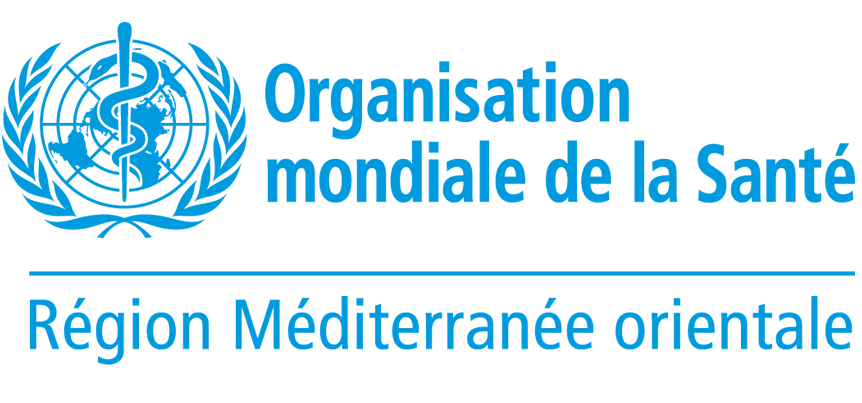Stopping polio in Yemen, one step at a time
 25 April 2024 – As long as a single child is infected with polio, all unvaccinated children are at risk of contracting the disease. In fragile and conflict-affected contexts, such as Yemen, children can be especially vulnerable. From 2021 to 2023, Yemen reported 237 variant poliovirus type 2 cases – from both circulating vaccine-derived poliovirus type 2 (cVDPV2) and vaccine-derived poliovirus type 2 (VDPV2).
25 April 2024 – As long as a single child is infected with polio, all unvaccinated children are at risk of contracting the disease. In fragile and conflict-affected contexts, such as Yemen, children can be especially vulnerable. From 2021 to 2023, Yemen reported 237 variant poliovirus type 2 cases – from both circulating vaccine-derived poliovirus type 2 (cVDPV2) and vaccine-derived poliovirus type 2 (VDPV2).
“We didn’t know we were supposed to take [our children] to the hospital to get vaccinated, and I wasn’t aware of the seriousness of these diseases or thinking that any of my children would get sick,” said a mother whose child contracted polio in 2021 and is now paralysed.
One in 4 children in Yemen cannot receive all the recommended vaccinations on the national routine immunization schedule. Indeed, 17% of Yemen’s children are considered zero-dose children – they have received no doses of vaccine. Low vaccination coverage, and increased vaccine hesitancy among parents are among the many factors that contribute to this situation.
Early on 25 February 2024, about 6700 fixed and mobile vaccination teams set out to reach nearly 1.3 million children aged under 5 years with the novel oral polio vaccine type 2 (nOPV2). Working from health facilities and on the streets of the 12 target governorates, the teams were determined to give children the 2 drops of vaccine needed to protect them from the debilitating disease.
Fig. 1. Geographic distribution of laboratory-confirmed variant poliovirus type 2 cases (2021–2023)
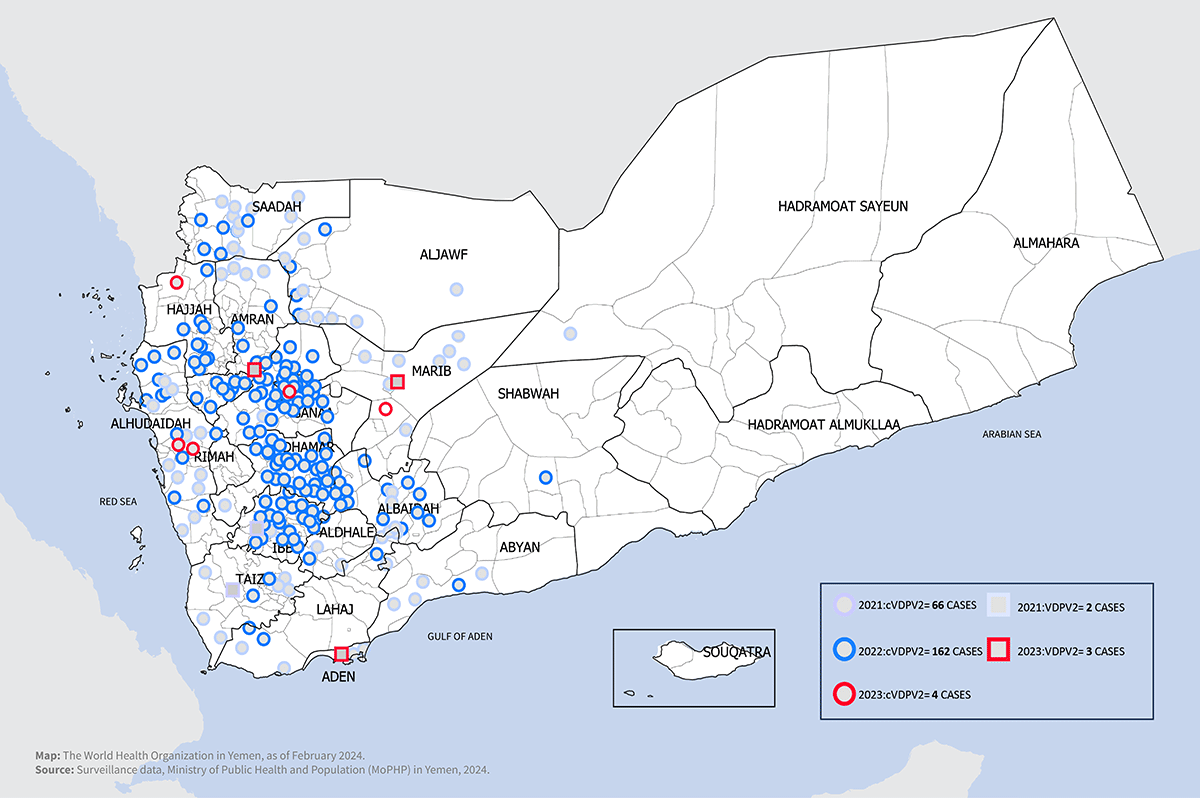 Disclaimer: The boundaries and names shown and the designations used on this map do not imply the expression of any opinion whatsoever on the part of the World Health Organization concerning the legal status of any country, territory, city or area or of its authorities, or concerning the delimitation of its frontiers or boundaries.
Disclaimer: The boundaries and names shown and the designations used on this map do not imply the expression of any opinion whatsoever on the part of the World Health Organization concerning the legal status of any country, territory, city or area or of its authorities, or concerning the delimitation of its frontiers or boundaries.
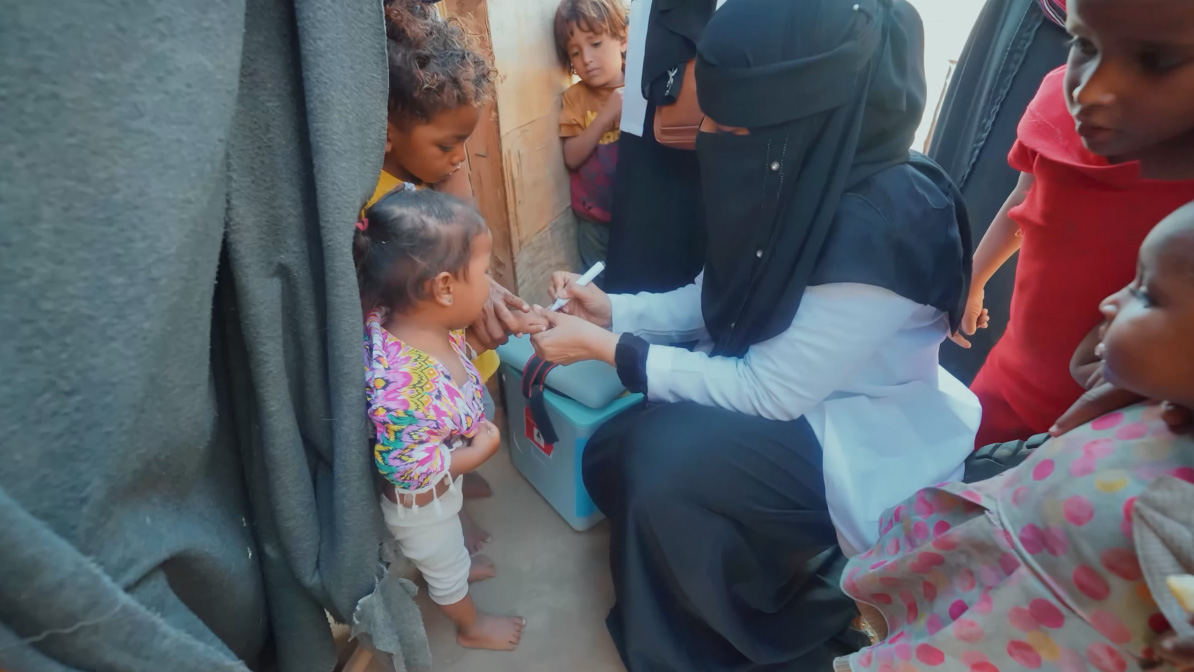
Carrying vaccine coolers, the vaccination teams travelled the roads of the targeted cities, their crumbling alleys a sign of the decade of conflict that has affected Yemen. Some areas were easy to access, but others involved arduous journeys to reach vulnerable children.
On the outskirts of cities, congested camps of internally displaced people reflect the impact of the protracted conflict. Dwellings are made of boards and old rugs, and access to safe water, sanitation and hygiene is lacking. Many of the families in the camps once had settled homes; their future is now uncertain.
Mobile vaccination teams find many deprived children as they go door to door, but sometimes the biggest challenge is to convince parents to vaccinate their children. Parents and caregivers are usually positive when teams approach them. But there is increased vaccine hesitancy and refusal among families affected by misinformation coupled with limited health literacy. This has left many children unprotected.
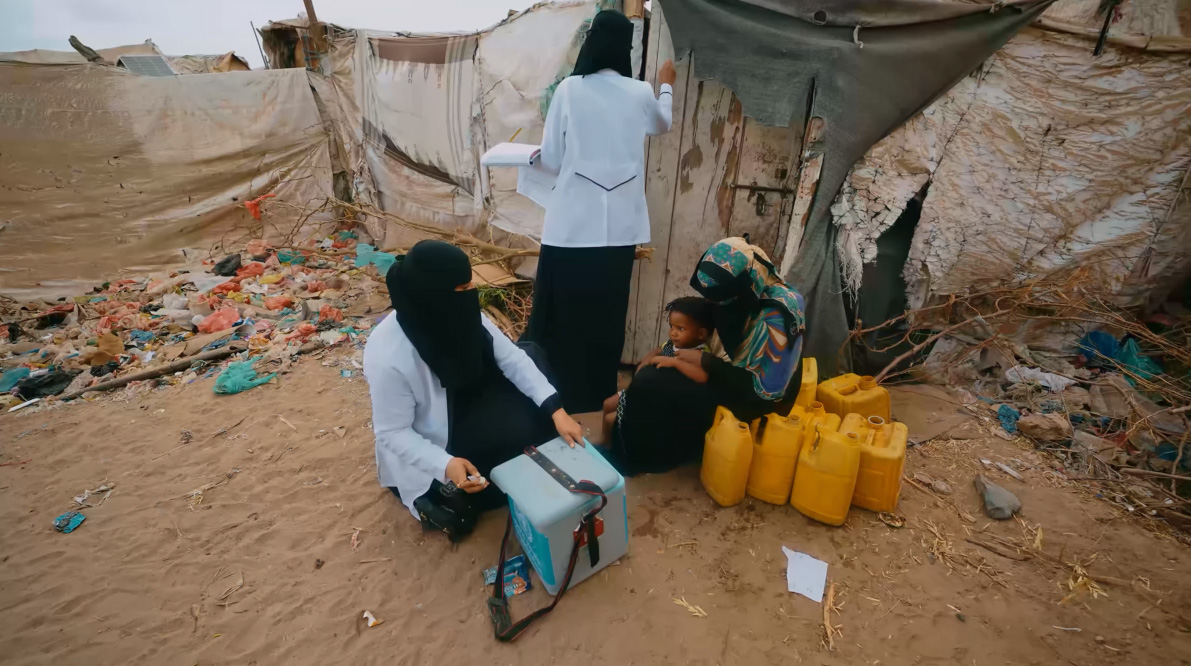 There is no cure for polio; it can only be prevented. The impacts of the conflict and adverse socioeconomic conditions have left many children in Yemen susceptible to the disease.
There is no cure for polio; it can only be prevented. The impacts of the conflict and adverse socioeconomic conditions have left many children in Yemen susceptible to the disease.
It is only thanks to parents who wait in long lines at health facilities and vaccination teams who travel long distances to vaccinate children that Yemen’s polio outbreak is not more widespread.
Yemen's Ministry of Public Health and Population carried out the polio immunization activities as part of a national immunization campaign funded by the Global Polio Eradication Initiative and supported by WHO and the United Nations Children’s Fund (UNICEF).
In total, the campaign reached 1.29 million vulnerable children across the 12 governorates. Teams delivered the polio vaccine to the doorstep of every home, shelter and camp in fragile communities to protect children’s health and future. The independent post-campaign monitoring data show that 91% of targeted children were reached during the supplementary immunization activity, with coverage by governorate ranging from 86% to 99%. Refusal was the main reason for children missed during the campaign.
Fig. 2. Immunization coverage rate in targeted governorates (25–28 February 2024)
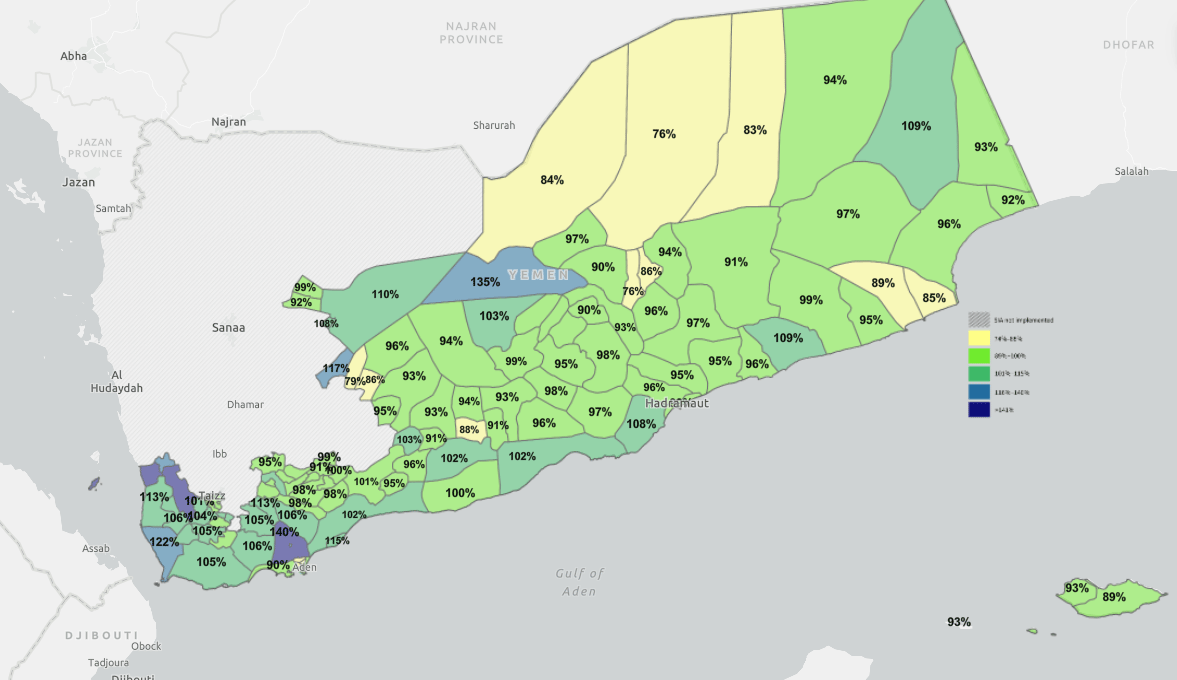
Multiple doses of polio vaccine offer the best protection to children, especially those living in fragile and conflict-affected settings. The Ministry, WHO and partners will take the lessons learned from this campaign and work with health workers to deliver another vital round of polio vaccine to these same communities in the coming months.
“People saw the deadly impact of diseases with their own eyes, so they would come to get vaccinated”
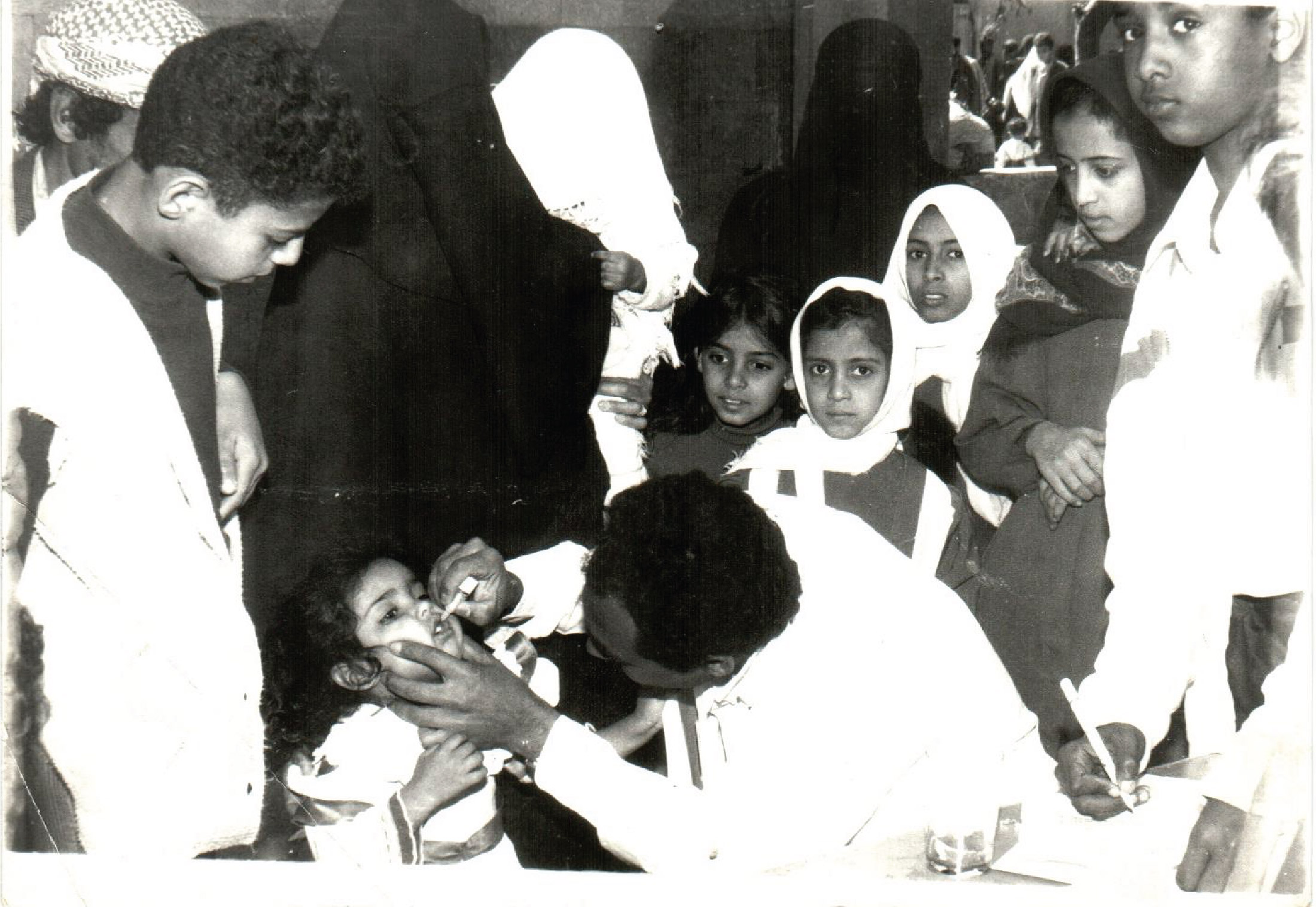 the Ministry of Public Health and Population25 April 2024 – Interview with Dr Mohammed Hajar, Advisor on Immunization to the Ministry of Public Health and Population, and one of the greatest minds behind the Essential Programme on Immunization (EPI) in Yemen.
the Ministry of Public Health and Population25 April 2024 – Interview with Dr Mohammed Hajar, Advisor on Immunization to the Ministry of Public Health and Population, and one of the greatest minds behind the Essential Programme on Immunization (EPI) in Yemen.
“I only came to this interview because EPI is one of my grandchildren.” These were the very first words uttered by Dr Mohamed Hajar, a man in his late seventies, as he entered the office for the interview.
“In Yemen, from 1970 to 1976, there was only the smallpox vaccine and field teams working to cover the governorates,” he went on. “But in 1977, the national Expanded Immunization Programme was established, and included basic vaccines, namely diphtheria, whooping cough, poliomyelitis, measles, tuberculosis, and tetanus for women. We started in only 3 governorates: Sana’a, Taiz and Hodeidah, because they had adequate roads and electricity.”
Before EPI, vaccinations were only provided through foreign teams such as the Peace Corps, Save the Children, a Norwegian group in Ibb governorate and a Swedish group in Taiz – all of which would provide people with vaccines without the administration of any national programme. But when EPI began, these international initiatives were introduced within its framework, and they were provided with EPI vaccines and associated forms. Immunization focal points under the supervision of the Ministry of Public Health and Population then followed up on coverage in each governorate.
Coverage was confined to these 3 governorates until the primary health care and immunization programmes were integrated in 1982. As a result, care units were expanded across Yemen’s governorates. Most units had a vaccination officer and a health worker, which increased immunization coverage. This also helped revitalize the primary health care programme, as demand for immunization was greater than for primary health care services.

Dr Hajar continued to recount the history of EPI: “In 2004, the second dose of the rubella vaccine was approved, while in 2005 the pentavalent vaccine [combined diphtheria-tetanus-pertussis vaccine, hepatitis B and Haemophilus influenzae vaccine] was introduced, having a significant impact in mitigating the incidence of these diseases. But one of the most important achievements was in 2009, when Yemen was declared free of the wild poliovirus. There has been no trace of the virus since 2006.”
Integrated efforts continued to strengthen the national EPI with new and improved vaccines, reducing the spread of the targeted viruses in Yemen. Vaccine preservation systems have also been strengthened, with cold chain systems a vital component. About 15 cold rooms, along with many refrigerators and coolers, have been added, and transport mechanisms enhanced at all subnational levels.
Manuals were developed and teams trained to help share knowledge and improve performance. All relevant documents were also provided, including records, children and women’s cards, and templates for daily and monthly reports from the subdistrict level to central level.
In the 1990s and early 2000s, polio immunization was carried out from fixed locations. In 2004, the strategy switched to house-to-house campaigns to ensure full coverage of all children aged under 5 years in all locations, including remote areas. This strategy continued until 2021, when the polio vaccine was confined to fixed sites in many areas in Yemen.
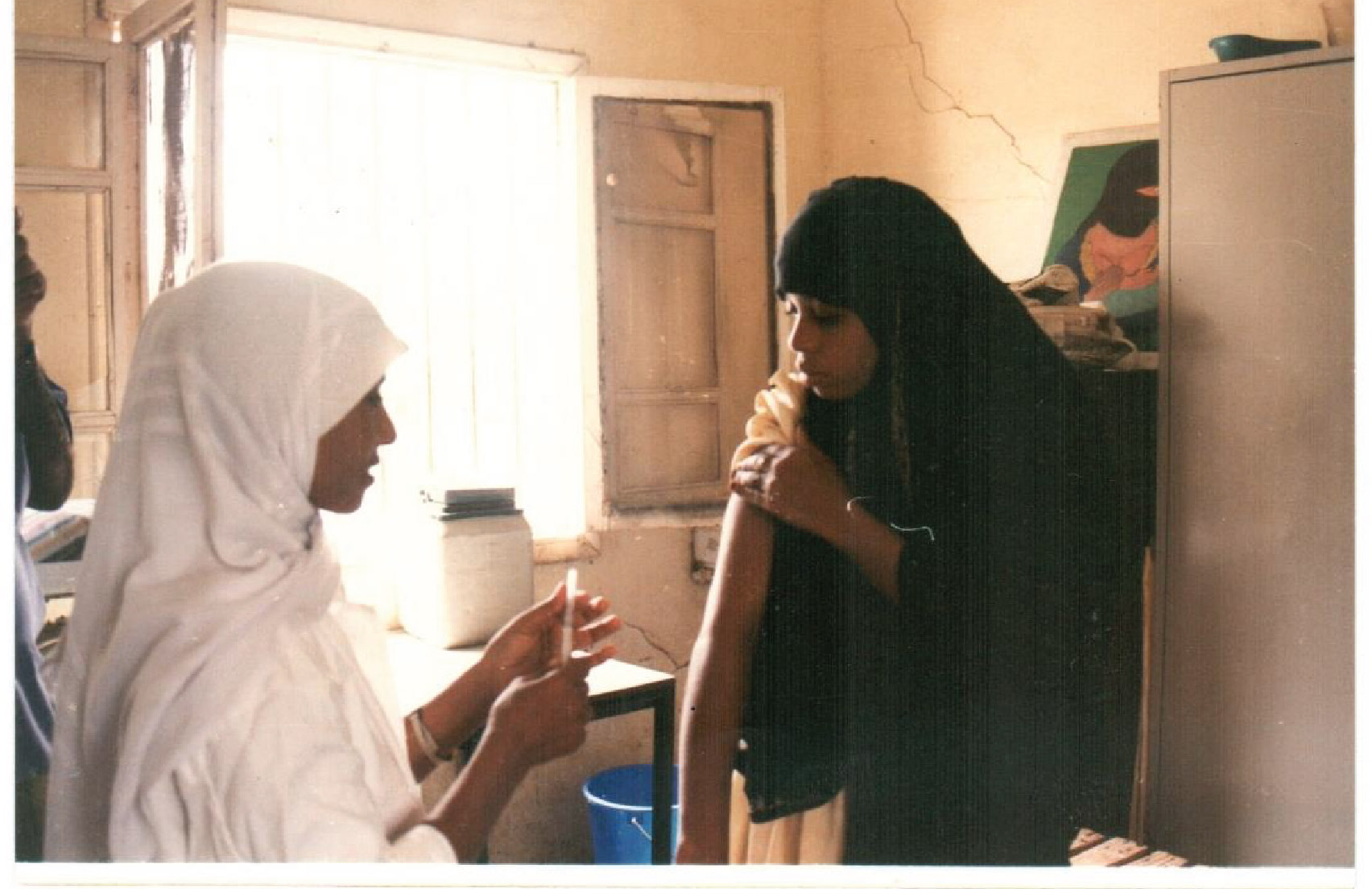
For decades, Yemen has promoted efforts that serve the health and well-being of its people, but the ongoing conflict has reversed all national gains and has paralysed development. Today, Yemen is witnessing the highest levels of health risks anywhere in the world, with a significant increase in the emergence of epidemics such as cholera, measles, diphtheria, dengue and polio. Public health infrastructure and services are limited, safe water sources are scarce, and vaccine hesitancy and refusal have increased.
“Previously, people saw the deadly impact of diseases with their own eyes, so they would come to get vaccinated,” explained Dr Hajar. “People had bitter experiences of smallpox, where those who were not vaccinated were either deformed or died; measles was when a child was either blinded or died, in most cases. When measles cases started, the uptake for vaccination was very high in all centres. People had an awareness of the importance of the vaccine and that it could save lives.”
He went on to share the situation now: “Yesterday I went to one of the fixed immunization sites. The workers were there to provide the vaccine, the vaccine is available, and all the means of recording and follow-up are available, but there are no families who are about to be vaccinated.”
Initially called the Expanded Programme on Immunization, this WHO initiative – which celebrates its 50th anniversary this week – is now known as the Essential Programme on Immunization. For about 47 years, Yemen has worked with WHO, various governments, local councils, international organizations and global initiatives to build its national EPI from nothing.
These partnerships continue to underpin Yemen’s immunization efforts to reach and protect children from vaccine-preventable deadly childhood diseases. And continuing these strong partnerships is the only way that Yemen can recover from the effects of conflict and protect the future of its children.
Strengthening preparedness at Yemen’s points of entry
 Participants of the point of entry training of trainers workshop in Aden, Yemen. Photo credit: WHO/WHO Yemen21 April 2024 – Yemen faces complex challenges made worse by 10 years of conflict. The deteriorating situation is coupled with a fragile health system, a lack of specialized staff, and a rise in health emergencies, some of which emerge from unexpected sources. Transport, travel and trade are linked to economic development but can also pose public health risks, causing diseases to spread across borders.
Participants of the point of entry training of trainers workshop in Aden, Yemen. Photo credit: WHO/WHO Yemen21 April 2024 – Yemen faces complex challenges made worse by 10 years of conflict. The deteriorating situation is coupled with a fragile health system, a lack of specialized staff, and a rise in health emergencies, some of which emerge from unexpected sources. Transport, travel and trade are linked to economic development but can also pose public health risks, causing diseases to spread across borders.
Points of entry ¬– airports, seaports, ground crossings ¬– pose unique health risks that require specialized capacities distinct from those needed in community and health facility settings. WHO works to enforce the International Health Regulations (IHR) at points of entry and build Yemen’s capacity to prepare for and respond to public health threats from unexpected sources.
Building capacities and pinpointing gaps
In December 2023, the WHO Country Office in Yemen gave a training of trainers workshop on IHR and its core capacities requirements for 14 key personnel from various sectors. These included points of entry staff; health inspectors from multiple airports, seaports and ground crossings; and personnel from national public health authorities.
The training enables participants to conduct national point of entry assessments effectively. The programme used a blended learning approach, combining theoretical sessions with practical field visits, letting participants gain valuable hands-on experience. Moreover, the training ended with a practical tabletop exercise designed to assess and reinforce essential public health functions at points of entry that align with IHR core capacities for prevention, early detection and response.
Standard operating procedures were devised to support the execution of routine activities and the response to international public health emergencies in line with IHR. A national training curriculum, stakeholder analysis, and guidelines on the purpose of IHR for workers at points of entry have also been developed.
 Point of entry assessment and visit to Seiyun Airport, Yemen. Photo credit: WHO, Yemen.The trained team, assisted by national and international experts, conducted national assessments at 10 strategic points of entry: 4 seaports, 3 airports and 3 ground crossings. The findings highlight strong multisectoral commitment and collaboration to fortify health infrastructure and capabilities. Yet they also reveal notable capacity gaps at points of entry premises and in information sharing across various levels.
Point of entry assessment and visit to Seiyun Airport, Yemen. Photo credit: WHO, Yemen.The trained team, assisted by national and international experts, conducted national assessments at 10 strategic points of entry: 4 seaports, 3 airports and 3 ground crossings. The findings highlight strong multisectoral commitment and collaboration to fortify health infrastructure and capabilities. Yet they also reveal notable capacity gaps at points of entry premises and in information sharing across various levels.
The assessments set the baseline for a comprehensive capacity-building plan based on immediate and long-term strategies. Pandemic Fund support will be used to address urgent needs, focusing on prioritized capacities in Yemen. It is vital, however, to sustain financial support and continuous capacity-building to maintain preparedness and response capabilities for public health threats at points of entry.
All hands on deck
Use of the capacity-building plan and the multisectoral assessments brings together stakeholders from human health, animal health, border control and other pivotal sectors. The aim is both to create a holistic understanding of capacities across various sectors, and to align strategies. This fosters a united front to effectively implement and sustain enhanced points of entry capacities that will ensure coordinated and comprehensive preparedness and response to public health threats.
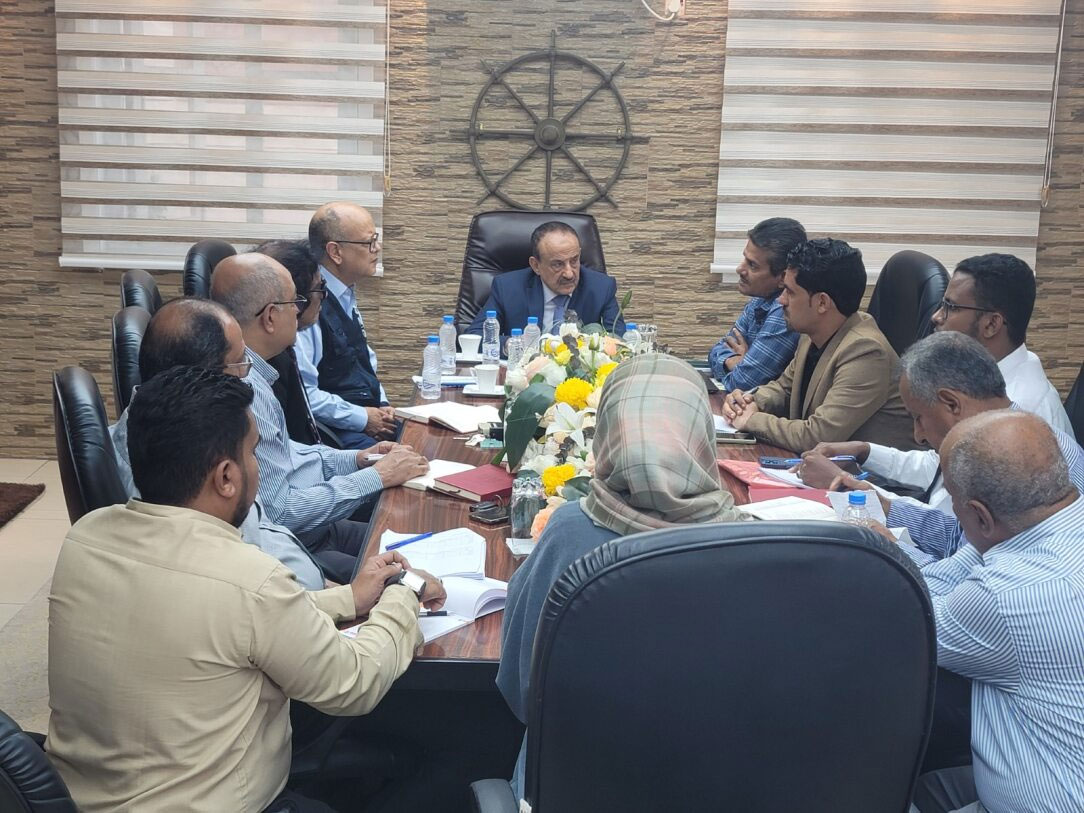 Multisectoral meeting at Aden Seaport, Yemen. Photo credit: WHO/WHO YemenThis WHO initiative to strengthen IHR core capacities at points of entry is crucial to enhance national, regional and global health security. Through unified efforts, Yemen is positioning itself at the forefront of health preparedness, showing its resilience and determination in the face of considerable challenges.
Multisectoral meeting at Aden Seaport, Yemen. Photo credit: WHO/WHO YemenThis WHO initiative to strengthen IHR core capacities at points of entry is crucial to enhance national, regional and global health security. Through unified efforts, Yemen is positioning itself at the forefront of health preparedness, showing its resilience and determination in the face of considerable challenges.
The success of this initiative hinges on the commitment of all involved parties. Collaboration is critical to prevent cross-border and international spread of disease and promote health security the world over.
The right to health: WHO works to bridge health divide in Yemen
 7 April 2024, Sana’a, Yemen – All people have the right to health. And no matter where they live, they should be able to access and afford quality health care when they need it. The prolonged conflict in Yemen has left half of the population in need of health aid .
7 April 2024, Sana’a, Yemen – All people have the right to health. And no matter where they live, they should be able to access and afford quality health care when they need it. The prolonged conflict in Yemen has left half of the population in need of health aid .
Vulnerable groups continue to bear the brunt of the crisis. Such groups include internally displaced people, children, women, elderly people, people with disabilities and mental health conditions, marginalized communities, and people affected by conflict-related injuries.
“The challenges that people in Yemen have to face cannot be described. Children who are referred to nutrition wards are only there because of prolonged starvation. The health system is fragile and faces difficulty in meeting the increasing demands,” said Dr Arturo Pesigan, WHO Representative in Yemen. “I feel for all the parents and caregivers who have to see their children getting ill in front of their eyes.”
Yemen faces a double burden of disease and armed conflict, and 17.8 million people in the country require health assistance. Of this number, 24% are women, who need access to diverse medical and reproductive health services. Children account for 50% of those in need, including 540 000 children aged under 5 years who require life-saving treatment for severe wasting – 10% of whom have severe acute malnutrition with medical complications and need highly specialized inpatient care. Inequalities are revealed in the high levels of malnutrition among mothers and children. Undernutrition remains a major public health crisis .
The multihazard risk profile for Yemen, the development of which WHO has supported, identifies 6 priority hazards with a high likelihood and potentially high public health impact: armed conflict, cholera, dengue, floods and cyclones, malaria and measles.
As the world marks the 76th World Health Day, WHO continues to support the health authorities to address the gaps, all the while working to strengthen the health system amid the conflict.
Through strong partnerships in 2023, WHO supported 245 health facilities to remain functional, providing 6.4 million outpatient consultations and reaching about 2.5 million people. Some 1.2 million children aged under 5 years were vaccinated against polio and another 1.1 million children (aged 6 months–4 years) were vaccinated against measles.
In addition, 4000 tonnes of medicines, equipment, medical furniture, information technology devices and other health technologies worth US$ 42.63 million in total were distributed to 470 health facilities across Yemen.
“Every number reflects a positive impact on people’s lives. These are men, women and children who were provided with life-saving services and were not turned away,” said Dr Pesigan. “A multisectoral approach is needed today to promote health and well-being while addressing determinants of health and risk factors. But if this is not combined with peace, true development may be difficult to achieve. Through peace, Yemen can start to heal.”
Media contacts
WHO Yemen Communications
Email:
About WHO
Since 1948, the World Health Organization (WHO) has been the United Nations agency dedicated to advancing health for all, so that everyone, everywhere can attain the highest level of health. WHO leads global efforts to expand universal health coverage, direct and coordinate the world’s responses to health emergencies and connect nations, partners and people to promote health, keep the world safe and serve the vulnerable.
